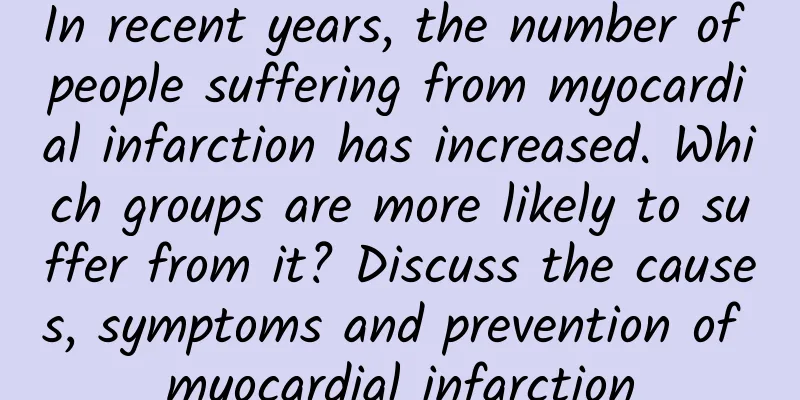In recent years, the number of people suffering from myocardial infarction has increased. Which groups are more likely to suffer from it? Discuss the causes, symptoms and prevention of myocardial infarction

|
If you pay attention to some examples around you, you will find that in recent years, more and more people have suffered from "heart attack", and they are getting younger and younger. Some people usually look healthy, but suddenly have severe chest pain, which disappears quickly, which is hard to accept. Why are more and more people suffering from heart attack now? Let's learn about the relevant knowledge about heart attack. Prevent heart attack and live a healthy life! 1. The appearance and causes of myocardial infarction Myocardial infarction is also called myocardial ischemic necrosis. Myocardial infarction is caused by the long-term instability of arterial plaques. After rupture, blood clots are formed in the blood vessels. After the blood clots block the blood vessels, the coronary arteries become narrow, and the coronary blood supply is sharply reduced or interrupted, which leads to acute and persistent myocardial ischemia in the myocardium of the coronary artery supply area, which further leads to myocardial necrosis. Coronary artery sclerosis is the most common cause of myocardial infarction. Healthy arteries are elastic, but over time, the walls of blood vessels gradually thicken and harden, forming plaques, a condition called atherosclerosis. On the basis of coronary atherosclerosis, unstable plaques lead to erosion and rupture, or even intra-plaque bleeding, thereby forming local thrombi and causing acute occlusion of the coronary arteries, resulting in persistent myocardial ischemia and hypoxia, and causing myocardial necrosis. However, a small number of patients do not have obvious blockage in their coronary arteries. The causes of myocardial infarction in these patients mainly include plaque rupture or plaque erosion, coronary artery spasm, coronary thrombosis and spontaneous coronary artery dissection. In addition, pathological conditions such as anemia, tachycardia, respiratory failure, heart failure, hypotension, shock, etc. can also induce myocardial infarction. Some other cardiovascular diseases can also cause myocardial infarction, such as hypertension, diabetes and hyperlipidemia. In addition, obesity caused by long-term improper diet or improper emotions for a long time may also cause myocardial infarction. Because these diseases and causes will cause secondary thrombosis in the patient's body, it will also reduce the blood supply to the myocardium, thus causing myocardial infarction. 2. People at high risk of myocardial infarction In principle, myocardial infarction can occur in people of any age. However, compared with young people, the physical condition and lifestyle of middle-aged and elderly people make them more susceptible to myocardial infarction. People at high risk of myocardial infarction include: 1. Patients with a history of coronary heart disease. Myocardial infarction is caused by atherosclerosis due to coronary artery disease. 2. Hypertensive patients. A sudden drop in blood pressure in hypertensive patients, accompanied by sweating, chest tightness, chest pain and other symptoms, is a precursor to acute myocardial infarction. 3. Middle-aged and elderly people with unexplained arrhythmia. Middle-aged and elderly people who suddenly develop unexplained arrhythmia, accompanied by heart failure, shock, and cerebral circulation disorders, should be taken seriously. 4. Middle-aged and elderly people with sudden impaired consciousness. Middle-aged and elderly people suddenly experience general fatigue, irritability, palpitations, impaired consciousness, and long-term examinations show bradycardia or arrhythmia due to heart failure. 5. Elderly people who feel short of breath and palpitation after exercise. Elderly people suddenly feel fatigue, sweating, chest tightness, palpitation and shortness of breath after exercise. 3. Clinical manifestations and signs of myocardial infarction. The clinical manifestations of myocardial infarction are that patients often show obvious and persistent severe pain behind the sternum, and may also experience fatigue, chest tightness, shortness of breath, dyspnea, cough, fever, increased white blood cell count and serum markers. In severe cases, patients may experience pale skin, cold limbs, low blood pressure and confusion. In particular, the increase in myocardial necrosis markers cannot be completely relieved by rest and nitrate drugs, accompanied by increased serum myocardial enzyme activity, and an electrocardiogram can often confirm the diagnosis. In addition, myocardial infarction can also induce a series of arrhythmias and shock, and even endanger life. Most people may not have any signs before a myocardial infarction. Most people have an acute myocardial infarction suddenly. Some patients will have some signs. Precordial pain is often the earliest symptom of acute myocardial infarction, which is more common in the early morning and may occur during rest or activity. It may last for a long time and not ease. A small number of patients do not feel pain, but experience symptoms of heart failure such as chest tightness, shortness of breath, difficulty breathing, and coughing at the onset of the disease, or shock symptoms such as confusion, pale skin, cold limbs, sweating all over the body, and low blood pressure. Patients with inferior wall myocardial infarction also show symptoms such as nausea, vomiting, and abdominal distension. 4. Prevention of myocardial infarction 1. Maintain a good mood, do not overwork or stay up late, and avoid eating foods that can cause "three highs", which are common causes of myocardial infarction. 2. In addition, you should eat a balanced diet (low-fat, low-cholesterol diet), quit smoking and drinking, and maintain a balanced mentality to avoid irritation and damage to blood vessels. 3. You should also eat fresh fruits and vegetables, as these foods have the effect of clearing blood vessels. Keep warm as winter is the season with a high incidence of myocardial infarctions, and the cold has a great impact on blood vessels. 4. People at high risk should take antiplatelet drugs (such as aspirin), beta-blockers, statins and ACEI preparations, control risk factors such as hypertension and diabetes, and have regular check-ups. 5. Participate in more sports, enhance blood circulation, and strengthen cardiopulmonary function, which are all very helpful in preventing myocardial infarction. Finally, I hope that every one of our friends can live and work in good health and happiness. (Author: Wu Xueyan) |
>>: Learn about autism in one minute
Recommend
Girls have unexplained muscle pain all over their body
The pace of life of modern people is relatively f...
Complete recipes for one week after medical abortion
In many areas, women have to stay in confinement ...
Causes of tinea cruris in women
From a medical perspective, there is no gender di...
Abdominal pain, is it gastroenteritis again? Changsha Fourth Hospital reminds: Beware of corpus luteum rupture!
Xiao Luo (pseudonym) is a college student. Some t...
What does it mean for girls to have a lot of hair?
Girls may have excessive body hair due to physiol...
What causes ovarian cysts during pregnancy?
What should I do if I have ovarian cysts during p...
Female urine smells like ammonia
Normal people's urine generally has no obviou...
Treatment of abnormal intrauterine echoes
Are you familiar with the term abnormal intrauter...
What should women do if their lower body becomes loose after giving birth?
Many men must have discovered a problem, that is,...
Can women drink red wine during menstruation?
In life, everyone should know that red wine is ve...
What is the normal amount of vaginal discharge for girls?
A girl's leucorrhea can indirectly reflect th...
Is the safe period self-test table really accurate?
For women in today's society, life pressure i...
What is the difference between coconut milk and coconut water? How to make coconut milk into coconut water
Coconut milk is a white liquid in coconuts. It is...
【Smart Farmers】Food Talk: A Picture to Understand Misunderstood Food Additives
[Smart Farmers][Food Talk] A picture to understan...
What to do for vaginal itching?
Sometimes women are embarrassed to go to the hosp...









